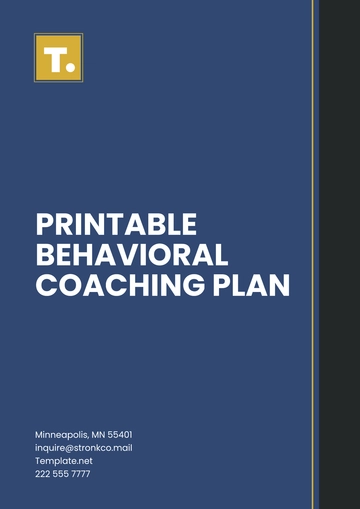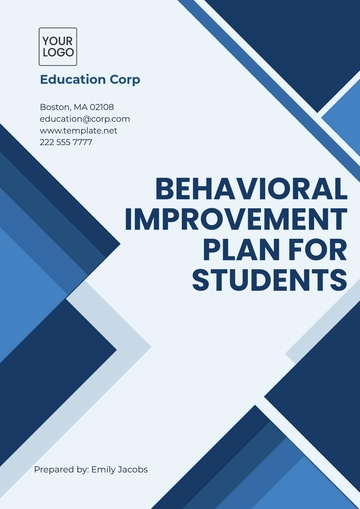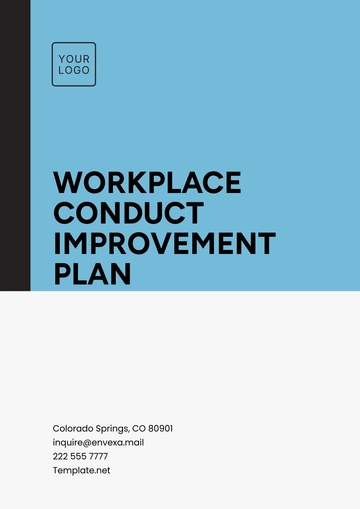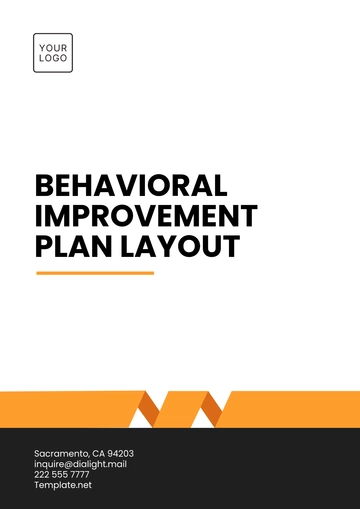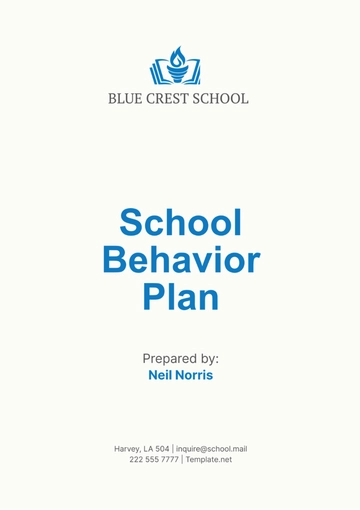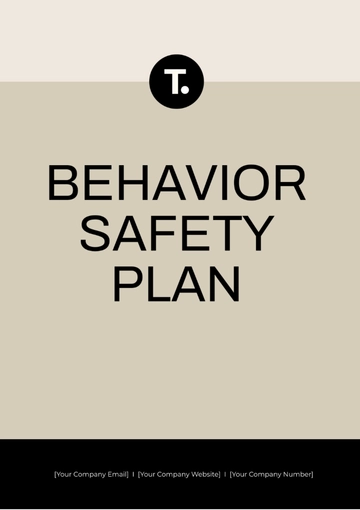Free School Behavior Plan
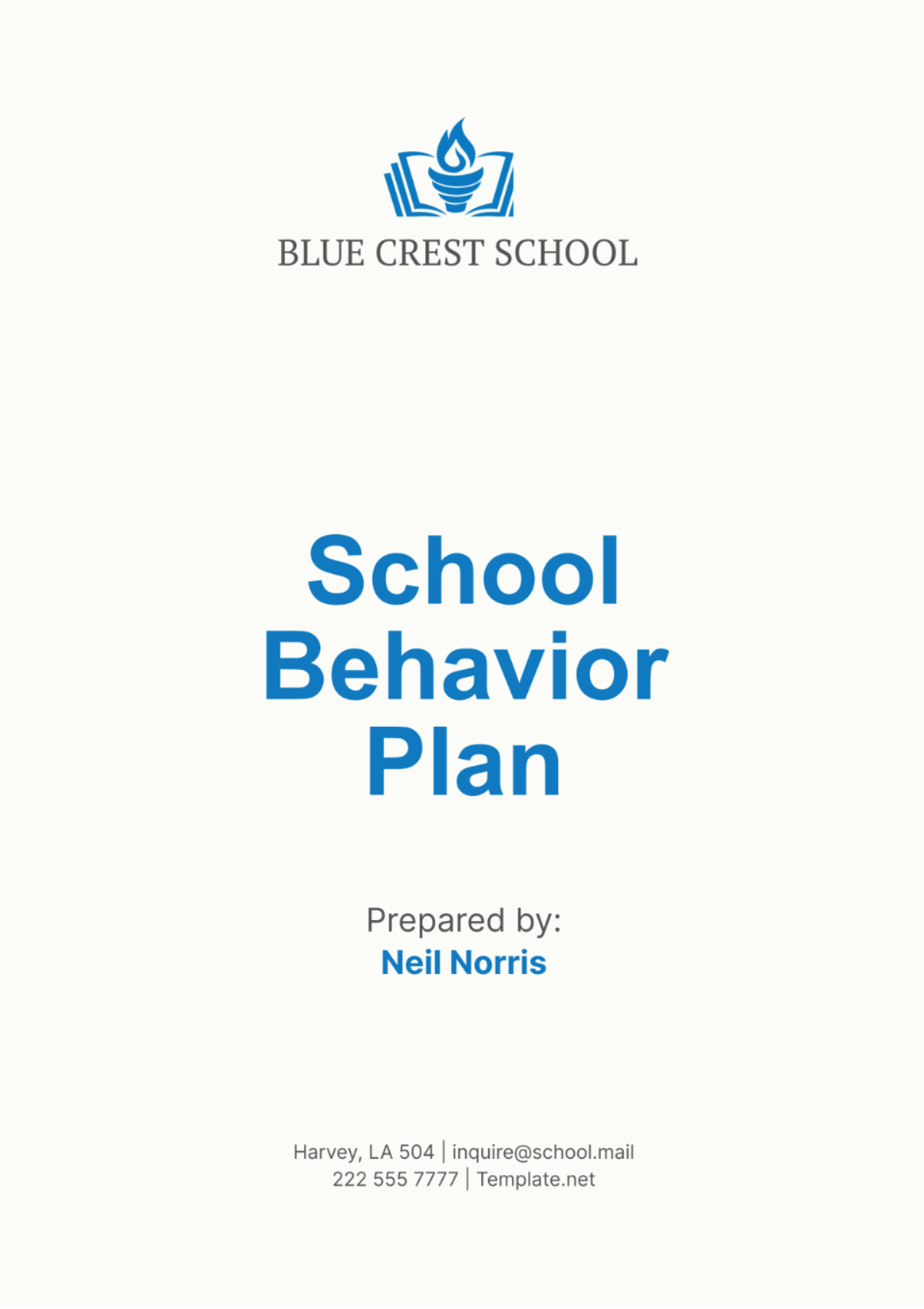
I. Introduction
A. Purpose of the Behavior Plan
The purpose of the Behavior Plan at [Your Company Name] is to establish a framework that promotes respectful, responsible, and safe behavior among students. This plan serves as a guide for students, teachers, and parents to understand the behavioral expectations and the processes in place for addressing misconduct. It aims to create a consistent approach to managing behavior, ensuring that all students have the opportunity to learn in a positive environment.
B. Objectives
The main objectives of this Behavior Plan are:
To define and communicate clear behavior expectations for all students.
To provide a structured approach for addressing both minor and major behavioral issues.
To implement positive behavior support strategies that encourage good conduct.
To ensure fair and consistent application of disciplinary measures.
To involve parents and guardians in the behavior management process.
To provide professional development for staff on effective behavior management techniques.
C. Scope
This Behavior Plan applies to all students, staff, and stakeholders at [Your Company Name]. It covers behavior expectations within the school premises, during school-sponsored activities, and in online interactions related to school activities. It aims to address a wide range of behaviors, from everyday classroom conduct to serious infractions, providing a comprehensive approach to behavior management.
II. Behavior Expectations
A. General Conduct
Students at [Your Company Name] are expected to conduct themselves with respect, responsibility, and integrity. Respect for others includes treating classmates, teachers, and school staff with kindness and consideration. Responsibility involves being accountable for one's actions, completing assignments on time, and participating actively in class. Integrity means being honest, following school rules, and making ethical decisions even when not being supervised.
B. Classroom Behavior
In the classroom, students must adhere to the following guidelines:
Attendance and Punctuality: Students should arrive on time for classes and attend all scheduled lessons unless excused for legitimate reasons. Regular attendance is crucial for academic success and helps maintain a stable learning environment.
Participation: Active participation in class discussions and activities is encouraged. Students should engage respectfully, listen attentively to others, and contribute meaningfully to group work.
Use of Materials: Students must use classroom materials responsibly, taking care of textbooks, equipment, and supplies. They should also avoid using unauthorized devices during class time, ensuring that their focus remains on learning.
C. Playground and Recreational Areas
The playground and recreational areas are essential for students' physical activity and social interaction. The following rules ensure safety and inclusivity:
Safety Rules: Students must follow all safety guidelines, such as using equipment properly, playing in designated areas, and avoiding rough or dangerous play.
Inclusivity in Games: All students should be included in games and activities. Excluding others or engaging in bullying behavior is strictly prohibited. Encouraging inclusive play helps build a sense of community and belonging.
D. Online Behavior
With the increasing use of technology in education, online behavior is a critical aspect of our Behavior Plan. Students must adhere to the following guidelines:
Cyberbullying Policy: Cyberbullying, defined as using digital platforms to harass or intimidate others, is not tolerated. Any incidents of cyberbullying will be investigated and addressed promptly.
Appropriate Use of Technology: Students should use school-provided technology for educational purposes only. They must avoid accessing inappropriate content, sharing personal information online, or engaging in any form of digital misconduct.
III. Positive Behavior Support
A. Recognition and Rewards
At [Your Company Name], positive behavior is recognized and rewarded to encourage students to maintain good conduct. Several programs are in place to acknowledge exemplary behavior:
Student of the Month: Each month, one student from each grade is selected as the "Student of the Month" based on their behavior, academic performance, and overall contribution to the school community. This recognition comes with a certificate and a small token of appreciation.
Certificates and Badges: Students demonstrating consistent positive behavior, such as helpfulness, leadership, or improvement in conduct, receive certificates and badges during school assemblies. These awards serve as tangible reminders of their good behavior.
B. Incentive Programs
To motivate students, [Your Company Name] has implemented various incentive programs:
Points System: Students earn points for good behavior, which can be accumulated and redeemed for rewards such as extra recess time, special privileges, or small prizes. The points system fosters a sense of achievement and encourages continuous positive behavior.
Special Privileges: Students who consistently exhibit good behavior may receive special privileges, such as leading school events, being a classroom helper, or participating in exclusive activities. These privileges serve as incentives for maintaining good conduct.
C. Role of Teachers and Staff
Teachers and staff play a crucial role in promoting positive behavior. They are expected to model the behavior they wish to see in students and use reinforcement techniques effectively:
Modeling Positive Behavior: By demonstrating respect, responsibility, and integrity in their actions, teachers and staff set a positive example for students to follow.
Reinforcement Techniques: Effective reinforcement techniques, such as praise, encouragement, and positive feedback, are used to acknowledge and promote good behavior. Teachers and staff receive training on these techniques to ensure consistency and effectiveness.
IV. Addressing Misconduct
A. Minor Misconduct
Minor misconduct refers to behavior that disrupts the learning environment but does not pose a serious threat. The following steps are taken to address minor misconduct:
Verbal Warnings: Teachers may issue verbal warnings to students who exhibit minor disruptive behavior. This initial step serves as a reminder to the student to correct their behavior.
Restorative Practices: When minor misconduct occurs, restorative practices such as peer mediation or conflict resolution are used to address the issue. These practices focus on repairing relationships and restoring harmony within the school community.
B. Major Misconduct
Major misconduct involves serious behavior violations that threaten the safety or well-being of others. The following procedures are in place to address major misconduct:
Detentions: Students involved in major misconduct may be assigned detention during or after school hours. Detention provides an opportunity for reflection and serves as a consequence for serious behavior violations.
Suspension Procedures: In cases of severe misconduct, suspension may be necessary. The suspension process involves notifying parents, providing a clear explanation of the behavior, and outlining the duration and terms of the suspension.
Expulsion Guidelines: Expulsion is considered a last resort for extreme cases of misconduct. The guidelines for expulsion include a thorough investigation, consultation with stakeholders, and adherence to due process to ensure fairness.
C. Investigation Process
When misconduct occurs, a structured investigation process ensures fair and consistent handling of the situation:
Reporting Misconduct: Incidents of misconduct should be reported promptly to the appropriate school authority. Teachers, staff, and students are encouraged to report any behavior violations they witness.
Fact-Finding Procedures: The school conducts a thorough investigation to gather facts and understand the circumstances surrounding the incident. This may involve interviews, reviewing evidence, and consulting with involved parties.
Decision Making: Based on the findings, the school administration makes an informed decision regarding the appropriate disciplinary action. The decision is communicated to the student and their parents, along with the rationale behind it.
V. Interventions and Support
A. Counseling Services
Counseling services play a vital role in supporting students who exhibit behavioral issues. The following counseling options are available:
Individual Counseling: Students may receive one-on-one counseling sessions to address specific behavioral concerns, develop coping strategies, and set personal goals for improvement.
Group Sessions: Group counseling sessions provide a platform for students to discuss common behavioral issues, share experiences, and learn from one another in a supportive environment.
B. Behavior Improvement Plans
For students with recurring behavioral issues, tailored interventions are implemented through Behavior Improvement Plans:
Tailored Interventions: Behavior Improvement Plans are customized to address the unique needs of each student. These plans outline specific goals, strategies, and support mechanisms to help the student improve their behavior.
Monitoring and Evaluation: Progress is monitored regularly to evaluate the effectiveness of the intervention. Adjustments are made as needed to ensure the student receives the necessary support for success.
C. Parental Involvement
Parental involvement is crucial in the behavior management process. [Your Company Name] encourages open communication with parents through the following means:
Communication Channels: Regular communication channels, such as emails, phone calls, and parent-teacher meetings, are used to keep parents informed about their child's behavior and progress.
Parent-Teacher Conferences: Scheduled conferences provide an opportunity for parents and teachers to discuss the student's behavior, identify areas of concern, and collaborate on strategies for improvement.
VI. Training and Professional Development
A. Teacher Training Programs
Teachers receive training to enhance their skills in managing student behavior effectively. The training programs include:
Classroom Management Techniques: Training on classroom management techniques helps teachers create a structured and conducive learning environment. This includes strategies for maintaining order, engaging students, and preventing disruptive behavior.
Conflict Resolution: Teachers are trained in conflict resolution techniques to handle disputes and conflicts among students effectively. These skills enable teachers to mediate conflicts and promote peaceful resolutions.
B. Staff Workshops
Staff workshops are conducted to provide ongoing professional development on understanding and managing student behavior:
Understanding Student Behavior: Workshops on understanding the underlying causes of student behavior help staff address issues more effectively. This includes recognizing behavioral triggers and implementing appropriate interventions.
Implementing Positive Reinforcements: Staff learn about various positive reinforcement techniques and how to apply them consistently and effectively. These workshops provide staff with the tools and strategies needed to create a positive and supportive learning environment for all students.
VII. Monitoring and Evaluation
A. Data Collection
Data collection is an essential component of monitoring student behavior. The following methods are used to collect data:
Method | Description |
|---|---|
Behavior Incident Reports | Teachers and staff use behavior incident reports to document behavioral issues. These reports include details such as the date, time, nature of the incident, and actions taken. |
Surveys and Feedback | Surveys and feedback from students, parents, and staff provide valuable insights into the effectiveness of the behavior plan. This feedback helps identify areas for improvement and informs future decision-making. |
B. Reviewing Effectiveness
The effectiveness of the behavior plan is reviewed through:
Method | Description |
|---|---|
Annual Reviews | An annual review of the behavior plan is conducted to assess its impact on student behavior and academic performance. This review includes analyzing data, gathering feedback, and making recommendations for improvement. |
Stakeholder Meetings | Regular meetings with stakeholders, including parents, teachers, and students, are held to discuss the behavior plan's effectiveness. These meetings provide an opportunity to address concerns, share feedback, and make adjustments to the plan as needed. |
VIII. Policy Review and Updates
A. Regular Review Schedule
The behavior plan is subject to regular review and updates to ensure its relevance and effectiveness. The following review schedule is followed:
Review Type | Description |
|---|---|
Annual Review | An annual review of the behavior plan is conducted to assess its effectiveness and make any necessary updates. |
Ongoing Monitoring | Ongoing monitoring of student behavior and feedback from stakeholders inform continuous improvements to the behavior plan. |
B. Stakeholder Involvement
Stakeholder involvement is crucial in the review and update process. The following stakeholders are involved:
Stakeholder | Involvement |
|---|---|
Parents | Parents are consulted through surveys, meetings, and feedback sessions to gather their input on the behavior plan. |
Teachers and Staff | Teachers and staff provide feedback on the behavior plan based on their experiences and observations in the classroom. |
Students | Students' perspectives are also considered through surveys and focus groups to ensure that the behavior plan reflects their needs and concerns. |
IX. Implementation of Changes
Any changes to the behavior plan are communicated clearly to all stakeholders. Training and support are provided to ensure that teachers and staff understand and can implement the changes effectively. Continuous monitoring and evaluation are conducted to assess the impact of the changes and make further adjustments as needed.
X. Conclusion
The School Behavior Plan at [Your Company Name] is designed to create a positive, safe, and inclusive learning environment. By setting clear behavior expectations, providing support for students, and implementing effective strategies for addressing misconduct, we aim to promote a culture of respect, responsibility, and integrity. Through regular monitoring and evaluation, we will continue to refine our approach to behavior management to ensure the success and well-being of all students.
- 100% Customizable, free editor
- Access 1 Million+ Templates, photo’s & graphics
- Download or share as a template
- Click and replace photos, graphics, text, backgrounds
- Resize, crop, AI write & more
- Access advanced editor
Develop effective behavior strategies with Template.net's customizable and editable School Behavior Plan Template. Customize the plan using the AI Editor Tool to meet your school's requirements. Ensure consistent and proactive behavior management with this comprehensive template.
You may also like
- Finance Plan
- Construction Plan
- Sales Plan
- Development Plan
- Career Plan
- Budget Plan
- HR Plan
- Education Plan
- Transition Plan
- Work Plan
- Training Plan
- Communication Plan
- Operation Plan
- Health And Safety Plan
- Strategy Plan
- Professional Development Plan
- Advertising Plan
- Risk Management Plan
- Restaurant Plan
- School Plan
- Nursing Home Patient Care Plan
- Nursing Care Plan
- Plan Event
- Startup Plan
- Social Media Plan
- Staffing Plan
- Annual Plan
- Content Plan
- Payment Plan
- Implementation Plan
- Hotel Plan
- Workout Plan
- Accounting Plan
- Campaign Plan
- Essay Plan
- 30 60 90 Day Plan
- Research Plan
- Recruitment Plan
- 90 Day Plan
- Quarterly Plan
- Emergency Plan
- 5 Year Plan
- Gym Plan
- Personal Plan
- IT and Software Plan
- Treatment Plan
- Real Estate Plan
- Law Firm Plan
- Healthcare Plan
- Improvement Plan
- Media Plan
- 5 Year Business Plan
- Learning Plan
- Marketing Campaign Plan
- Travel Agency Plan
- Cleaning Services Plan
- Interior Design Plan
- Performance Plan
- PR Plan
- Birth Plan
- Life Plan
- SEO Plan
- Disaster Recovery Plan
- Continuity Plan
- Launch Plan
- Legal Plan
- Behavior Plan
- Performance Improvement Plan
- Salon Plan
- Security Plan
- Security Management Plan
- Employee Development Plan
- Quality Plan
- Service Improvement Plan
- Growth Plan
- Incident Response Plan
- Basketball Plan
- Emergency Action Plan
- Product Launch Plan
- Spa Plan
- Employee Training Plan
- Data Analysis Plan
- Employee Action Plan
- Territory Plan
- Audit Plan
- Classroom Plan
- Activity Plan
- Parenting Plan
- Care Plan
- Project Execution Plan
- Exercise Plan
- Internship Plan
- Software Development Plan
- Continuous Improvement Plan
- Leave Plan
- 90 Day Sales Plan
- Advertising Agency Plan
- Employee Transition Plan
- Smart Action Plan
- Workplace Safety Plan
- Behavior Change Plan
- Contingency Plan
- Continuity of Operations Plan
- Health Plan
- Quality Control Plan
- Self Plan
- Sports Development Plan
- Change Management Plan
- Ecommerce Plan
- Personal Financial Plan
- Process Improvement Plan
- 30-60-90 Day Sales Plan
- Crisis Management Plan
- Engagement Plan
- Execution Plan
- Pandemic Plan
- Quality Assurance Plan
- Service Continuity Plan
- Agile Project Plan
- Fundraising Plan
- Job Transition Plan
- Asset Maintenance Plan
- Maintenance Plan
- Software Test Plan
- Staff Training and Development Plan
- 3 Year Plan
- Brand Activation Plan
- Release Plan
- Resource Plan
- Risk Mitigation Plan
- Teacher Plan
- 30 60 90 Day Plan for New Manager
- Food Safety Plan
- Food Truck Plan
- Hiring Plan
- Quality Management Plan
- Wellness Plan
- Behavior Intervention Plan
- Bonus Plan
- Investment Plan
- Maternity Leave Plan
- Pandemic Response Plan
- Succession Planning
- Coaching Plan
- Configuration Management Plan
- Remote Work Plan
- Self Care Plan
- Teaching Plan
- 100-Day Plan
- HACCP Plan
- Student Plan
- Sustainability Plan
- 30 60 90 Day Plan for Interview
- Access Plan
- Site Specific Safety Plan
